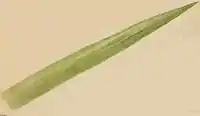Elachista poae
Elachista poae is a moth of the family Elachistidae found in Europe.
| Elachista poae | |
|---|---|
.jpg.webp) | |
| Elachista poae Deeside, North Wales | |
| Scientific classification | |
| Domain: | |
| Kingdom: | |
| Phylum: | |
| Class: | |
| Order: | |
| Family: | |
| Genus: | |
| Species: | E. poae |
| Binomial name | |
| Elachista poae | |
Description
The wingspan is 9–12 mm. The head is blackish. Forewings are blackish, somewhat pale-sprinkled, basal area somewhat lighter ; an obscure fascia before middle, angulated outwards in middle and inwards on fold, a small ill -defined tornal spot, a more distinct one on costa opposite, and traces of an angular mark in disc beyond and connecting these whitish, in female more distinct. Hindwings are dark grey.The larva is whitish -yellowish ; head and two spots on 2 pale brown..[2]
Adults are on wing from April to May and from June to August.[3]
The larvae feed on reed sweet-grass (Glyceria maxima), mining the leaves of their host plant. The mine has the form of a narrow gallery, descending from the leaf tip to within the sheath of the leaf. The frass is dispersed. Pupation takes place outside of the mine.[4] Larvae can be found from April to May and again from July to August.
Distribution
It is found from Fennoscandia and the Baltic region to Belgium, the Alps and Hungary and from Ireland to Romania.[5]
References
- "Elachista (Elachista) poae Stainton, 1855". Fauna Europaea. Retrieved 12 March 2020.
- Meyrick, E., 1895 A Handbook of British Lepidoptera MacMillan, London pdf
 This article incorporates text from this source, which is in the public domain. Keys and description
This article incorporates text from this source, which is in the public domain. Keys and description - "microlepidoptera.nl". Archived from the original on 2011-05-01. Retrieved 2011-09-12.
- "bladmineerders.nl". Archived from the original on 2012-09-26. Retrieved 2011-09-12.
- Ellis, W N. "Elachista poae Stainton, 1855 sweet-grass dwarf". Plant Parasites of Europe. Retrieved 12 March 2020.

